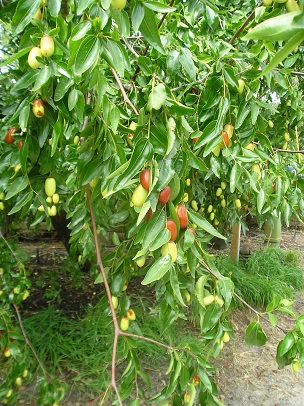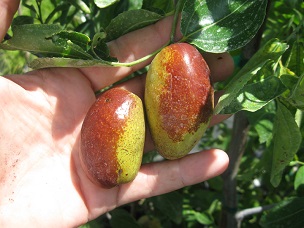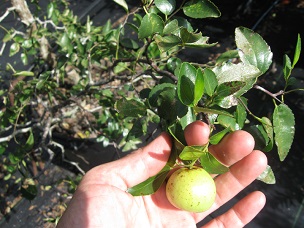Fact Sheet from
Just Fruits and Exotics Nursery
by Marquetta Cowley
Jujuba, Fruit for the Reluctant Gardener!

'Tigertooth'
What
thrives on neglect, loves long hot summers, is salt and drought
tolerant, can survive -28F (yup, that’s negative 28) and produces
tons of fruit??? – JUJUBA!!! “Jujuba, what the heck is
that?” you may ask. Jujuba (Ziziphus jujuba)
comes from China and is a sweet fruit with an apple like flavor. You
may have heard of it as Jujube or Chinese date. Some varieties, like
Tigertooth, have the shape and coloring of a date, hence the nickname.
Depending on the variety Jujuba fruit can be as small as a cherry or as
large as a plum.
While not commonly found in every orchard or
nursery, seedling Jujubas were introduced into the USA as early as
1837. In 1908, known cultivars were imported by USDA agricultural
explorer Frank N. Meyer (the same guy who got us the wonderful Meyer
Lemon!). Frank Meyer eventually brought 67 accessions to the USDA
California Chico Station and other USDA stations for cultivation
research. Jujubas can now be found in California, New Mexico, Arizona,
Washington, Pennsylvania, Illinois, Indiana, Kansas, Oklahoma, Texas,
Florida, Alabama, Georgia, Mississippi, Tennessee, South Carolina and
North Carolina.

'GA866'
The
Jujuba is a deciduous tree with shiny, 1-2 inch long, green oval leaves
and some thorns on the new growth dependant on the cultivar. Most
varieties have a graceful, drooping shape and will grow to 20ft tall
(30-40ft if not pruned). Plants do have a habit of suckering from the
root system, but these suckers can easily be kept at bay by mowing.
Jujubas
bloom in late spring, thus avoiding late freezes, and the fruit ripens
constantly from August to October. No worries about your fruit coming
all at once! Once the fruit starts turning brownish red to solid brown
red is when you harvest. Try a few to see at which stage you like best.
Fully ripe is when the fruit is a solid mahogany color. Don’t
pick green fruit as they won’t ripen once off the tree.
Jujubas
have a thin edible skin, sweet white flesh and a hard stone in the
center containing 2 seeds. Ripe fruit will last 1 week at room
temperature. Jujubas are great fresh, dried, candied or preserved.
Nutritionally,
100 grams (3.6 ounces) of raw Jujubas have 69 mg of Vitamin C whereas
an equal amount of orange only has between 45-59 mg. Check out the USDA
National Nutrient Database website for more nutritional information on
Jujubas and other fruits: http://ndb.nal.usda.gov/ndb/search/list.

'So'
Jujubas
are self fertile, have no serious disease, insect or nematode problems,
and do very well in poor soil. They prefer sandy, well drained soils
over heavy, wet soils. Jujuba trees need lots of sun,
15 feet of
spacing, fertilizer and regular water to ensure good fruit quality. Buy
a tree that is grafted or cutting grown to ensure you get the variety
you want as Jujubas grown from seeds won’t come true. For all
those folks who thought they couldn’t grow a fruit tree (without
killing it!) give the Jujuba a try. Be sure to check out our selection
of Jujuba in our online store.
Don’t know what to do with
jujuba fruit? Here’s a recipe for Jujuba Butter from the USDA
publication B-1215 titled “Methods of Utilizing the Chinese
Jujube” (my additions are in italics as the original directions
needed clarification).
Jujube Butter
6 pints raw jujube pulp (12 cups)
1 teaspoon nutmeg
½ teaspoon cloves
2 teaspoons cinnamon
5 pints sugar (10 cups)
¼ pint vinegar (1/2 cup)
1 lemon (cut up)
Boil
jujuba fruit with lemon until tender in sufficient water to cover it.
Rub cooked fruit through a sieve or colander to remove the skin and
seeds. Add spices, sugar and vinegar and bring to a second boil. Cook
slowly until thick, put in jars and seal while hot.
Sounds
yummy!!! Try substituting jububas for apples or pears in your fruit
butter recipe. If you have a favorite jujuba recipe, let us know and
we’ll share it.
Back to
Chinese Date Page
|
|


